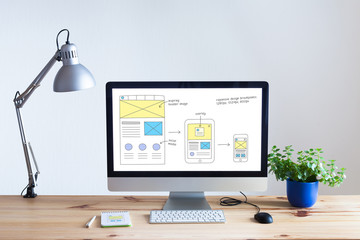Whether you are building a new website or redesigning your current one, you will need to design it in a way that will keep visitors engaged. You can use design elements such as white space, branding, navigation menus, and usability tests. Using white space in your Web Design can enhance your site’s overall user experience. The right white space will help visitors focus on the most important information. However, too much white space will make your website look cluttered and unappealing.
 Aside from increasing the legibility of your content, whitespace can also increase the number of times a visitor engages with your website. As a result, whitespace is a crucial component of your website’s design. Regardless of your website type, using the proper white space will ensure that your users have the most positive user experience possible. You can achieve this through a few simple steps. First, you must identify your audience. Knowing what they want will help you decide which spaces to use.
Aside from increasing the legibility of your content, whitespace can also increase the number of times a visitor engages with your website. As a result, whitespace is a crucial component of your website’s design. Regardless of your website type, using the proper white space will ensure that your users have the most positive user experience possible. You can achieve this through a few simple steps. First, you must identify your audience. Knowing what they want will help you decide which spaces to use.
Having an effective navigation menu is a vital component of a successful website. A good navigation menu should be visually interesting, meaningful, and easy to understand. With usable navigation, users will be able to find the information they need. Before designing your site, determine what you want to accomplish. This will allow you to design your site’s structure most efficiently.
There are many ways to create a website menu. Some options are hamburger icons, horizontal navigation, vertical navigation, or dropdown navigation. You can also use color to separate your menus from the rest of your website. When designing your site, you should keep your target audience in mind. Using data to guide your navigation can help you overcome “I think this will work” moments.
Using usability tests for website design can help you improve your site’s navigation and interaction. This can increase your users’ satisfaction and make them more likely to visit your website again. The process is quite simple. The first step is to determine what data you want to collect. You can carry out a usability test on your own or hire an expert. Next, choose the testing method that is most appropriate for your project. This could include an online survey, a focus group, or a moderated test.
After the test is complete, you should analyze your results. Compare them to your test criteria and then use them to make changes to your site. The primary goal of a usability test is not to test your users but to evaluate the effectiveness of your website’s interface. The test should highlight areas of concern and improve your users’ experience. Adding a little bit of branding into your website design effectively builds trust with your customers. Increasing customer retention by just 5% can boost your profits by 25% to 95%.
The name of the game is to get your users to take action. Your site navigation will include categories, pages, links, and calls to action. The trick is to ensure that all of these are well organized and the information is presented orderly. This is best achieved by making your site easy to navigate and intuitive. In the website design world, an image is one of the most important aspects of a site. An upscale fashion retailer website will be different from a technology company site. The trick is to ensure that the brand images used in the layout are implemented tactfully.
Creating a website design that will convert your visitors is crucial to your success. Whether running an e-commerce site or a traditional business, conversions can help you achieve your goals. These conversions can include buying a product, signing up for a newsletter, or sharing a blog post on social media. Understanding the impact of UX design on conversion rates will provide a higher ROI on your design projects. It will also remove potential roadblocks. Ultimately, a successful website will consistently generate revenues and profits. Creating a conversation is one of the most important aspects of your website design. By having a clear path for the visitor to follow, you will increase the chances of them converting.
Another aspect of website design that can influence conversions is the design of the CTA (call to action) button. A call to action is a button, line of text, or image that tells the visitor what to do when they visit your website. You want to make sure that every element on your page is working towards the same conversion.